We are oftentimes asked to compare our products to those of our competitors. One of the newer brands to enter the market is the Autonomous SmartDesk 2. Because their electric standing desks are quite a bit less money, customers will often ask why the VertDesk v3 is more expensive than the SmartDesk 2. While both desks are electronically operated, they do have quite a few differences. Those differences could potentially make either desk a good fit for you, depending on your specific needs. Let’s take a closer look at both of these desks to see which might be the right desk for you.
Full Disclaimer: We are an office furniture dealer and sell some of the height adjustable standing desks we review. To learn more about the products we sell, our review process and why you can trust us, please visit: Why we’re different. Who is BTOD.com and The Breakroom Blog?
Autonomous vs VertDesk v3
– OEM Manufacturer
– Where Are Components Made?
– Pricing
– Assembly
– Specs / Features
– Stability
– Electronics
– How They Operate
– Return Policy and Warranty
– Bottom Line
OEM Manufacturer
The Autonomous SmartDesk has gone through some changes with their OEM manufacturer since their launch in 2015. Their first version, The SmartDesk 1, was produced by the popular manufacturer JieCang. With the introduction of the SmartDesk 2, Autonomous moved their manufacturing over to a company called Aoke Furniture. Aoke is based in the city of Ningbo, China. Aoke has been in business since 2012.
The VertDesk v3 OEM manufacturer is K&A Mfg. Inc, makers of RA Products and the high-end standing desk brand, NewHeights. Based out of Wisconsin, they were established in 1985 as an ergonomic furniture company. Over the past 30 plus years, K&A Mfg. has continued to evolve, now producing a complete line of office furniture. K&A has been manufacturing electric standing desks since 2002, establishing themselves as a leader in the US Market.
Where are the components made?
| Autonomous SmartDesk 2 | VertDesk v3 | |
| Frame | China | Taiwan |
| Electronics | China | Austria |
| Gears | China | Germany |
| Assembly | China | USA |
2024 Pricing
The Autonomous Pro is anywhere from 22-29% less for similar sizes than the VertDesk v3. The Autonomous Desk is available in two different size options, with a 29″ x 53″ and 30″ x 70″ option. All VertDesk v3 tops are made to order and it currently has 304 different size options. The depth of the VertDesk is available in full inch increments from 23″ up to 30″ deep. The width is also available in full inch increments from 36″ up to 72″ wide, plus an additional 84″ wide option. The current lead time for the Autonomous desks is one business day. The current VertDesk v3 lead time for the base is five business days.
SmartDesk 2 Pricing
| 53” x 29” Standard Top + Frame | $599 |
| 70” x 30” XL Standard Top + Frame | $839 |
| 53” x 30” Bamboo Top + Frame | $749 |
VertDesk v3 Pricing
| Desk Size (D x W) | Pricing |
| 23″ – 30″D x 36″W | $839.99 |
| 23″ – 30″D x 37” – 42”W | $863.99 |
| 23″ – 30″D x 43” – 48”W | $874.99 |
| 23″ – 30″D x 49” – 54”W | $916.99 |
| 23″ – 30″D x 55” – 60”W | $919.99 |
| 23″ – 30″D x 61” – 66” W | $930.99 |
| 23″ – 30″D x 67” – 72” W | $1009.99 |
| 23″ – 30″D x 84” W | $1379.99 |
Assembly
The assembly process for both desks was straight forward. Depending on your skill level, the VertDesk will require 30-90 minutes for assembly and the Autonomous around 60-90 minutes.
I really like how Autonomous has separated their hardware and labeled each bag. This was nice because the Autonomous desk requires quite a few screws and it made the process of locating them easier. The base assembly process for the Autonomous SmartDesk 2 requires you to attach the feet and upper supports to the columns (legs). You will also need to assemble the upper cross support and attach it to the columns. While some of the holes in the upper cross support are recessed and difficult to reach, all of the screws screwed into the base without a lot of effort. The recessed holes are the only real pain point during assembly.
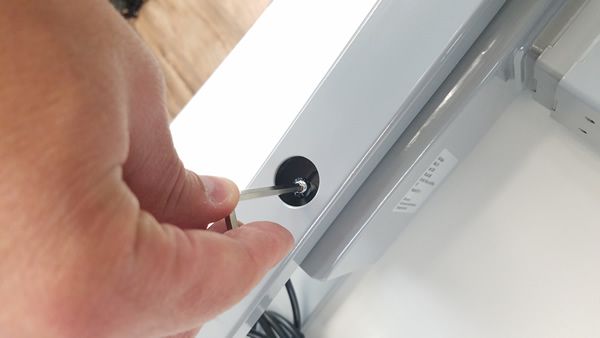
The VertDesk v3 ships with the feet and upper worksurface support attached to the columns. This cuts down on assembly time quite a bit. The VertDesk v3 does require you to attach the motor and insert the hexrod into each leg. If the inputs for each leg are not perfectly aligned, you may need to use a wrench to turn the hexrod 1/12 turn to slide it into place. This is the only real pain point during the assembly of the VertDesk v3 base. After you have attached the hexrod, you can complete the base assembly by attaching the cross support.
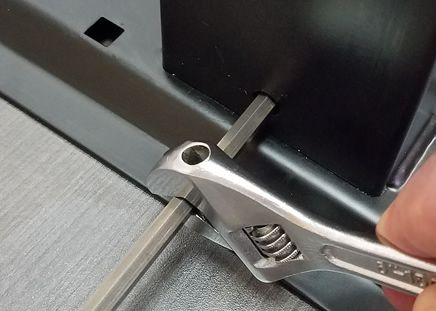
Standard Specs/Features Base Only
| Features | Autonomous SmartDesk 2 | VertDesk v3 |
| Button Options | Four preset programmable button standard | Up/down push button standard |
| Lift Capacity | 300 lbs. | 275 lbs. |
| Motor(s) | Dual | Single |
| Adjustment Range | 24” to 51” | 27” to 47.5” |
| Adjustment Speed | 2.09” per second | 1.55” per second |
| Soft Start – Stop | Yes | Yes |
| Auto-dark LED Display | Yes | Yes |
| Leveling Glides | .5” adjustment | .5” adjustment |
| Expandable Frame | 42” to 72” wide | n/a |
| Anti-Collision | Yes | Yes |
| Overload Protection | No | Yes |
| Frame Material | Steel | Steel |
Stability Of Each Desk
The stability of a standing desk is an important question for many customers. Design flaws in these types of desks are quickly realized once a desk is raised into standing position. We typically look at two different motions on a standing desk; a front to back rocking motion and a left to right wobble. Each of these can create an annoyance that will make it difficult to concentrate on your work.
WobbleMeter Testing Autonomous vs VertDesk v3
If you would like to see the pictures and videos of us testing the Autonomous SmartDesk 2 and VertDesk v3 on the WobbleMeter, please visit the page for each brand (Autonomous WobbleMeter and VertDesk v3 WobbleMeter). Below is the deflection score range guide for the WobbleMeter. How these results impact your experience will depend on your sensitivity to wobble and rocking motions.
If you’d like to learn more about using the WobbleMeter visit: what is the WobbleMeter?.
WobbleMeter Score Range Guide

0-20 = Excellent Stability
Almost all of the desks tested at sitting height will score between 0-20. This is our baseline for excellent stability since most standing desks provide excellent stability at their lowest heights. Users in this range will not notice motion.
21-30 = Very Good to Good Stability
Between 20-30, most users will not notice the small amount of motion in this range.
31-40 = Good to Fair Stability
Between 31-40, some users may begin to notice the amount of motion in this range. This is especially true the closer the score is to 40.
41-50 = Fair to Bad Stability
Between 41-50, most users will notice the amount of motion in this range. This is especially true the closer the score is to 50.
51-60+ = Very Bad Stability
Between 51-60+ all users will notice the amount of motion in this range. This is especially true for scores that are above 60.
WobbleMeter Results for Autonomous Frame
Overall Wobble (Side to Side) Deflection Scores
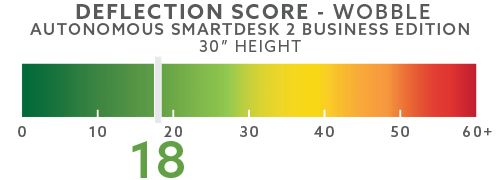
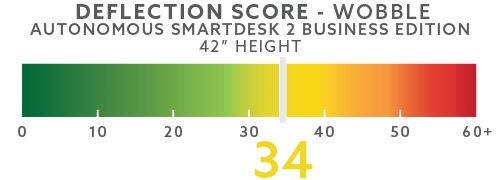
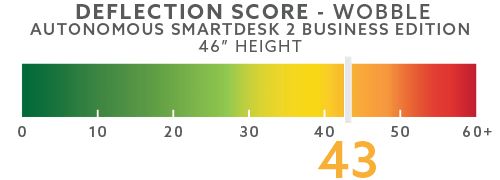
Overall Rocking (Front to Back) Deflection Scores
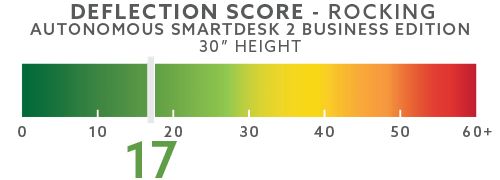
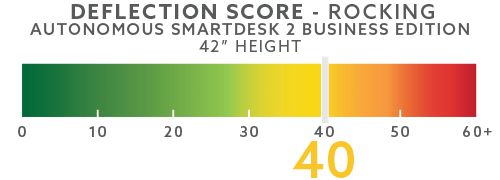

WobbleMeter Results for VertDesk v3 Frame
Overall Wobble (Side to Side) Deflection Scores



Overall Rocking (Front to Back) Deflection Scores

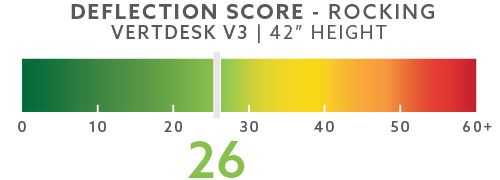
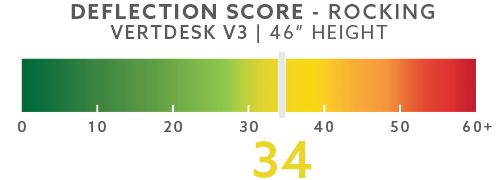
Note: It’s very important with adjustable standing desks to fully tighten all hardware. If there is hardware that is not completely tight, the movement experienced when extended to standing height will be exaggerated.
Four Major Reasons For Differences In Stability
Foot Design
The first is within the foot design. Similar to the Evodesk, the Autonomous foot has tapped out the bottom steel plate to attach the adjustable glides. Doing this saves on the overall cost, but only creates three lines of threading to attach the glide. The VertDesk v3 uses a better system, with threaded rivnuts that provide five lines of threading. This creates a better connection between the glide and foot.
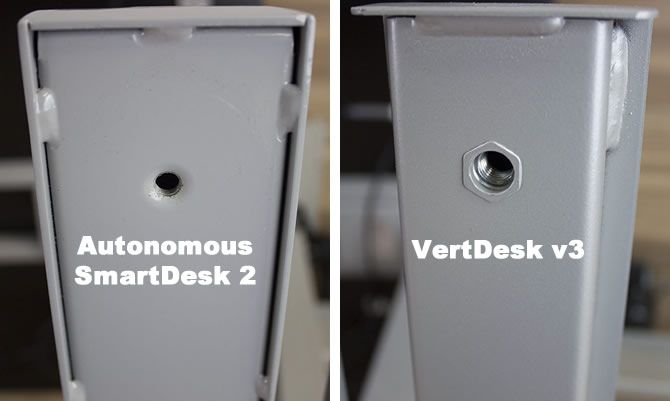
How Feet and Upper Supports Attach To Column
The second reason is how the feet and upper supports are attached to the columns (legs). Autonomous SmartDesk’s frames are shipped completely disassembled. This means you are attaching the feet and upper supports in the field. Because they are attached with screws, the stability will greatly depend on how tight you are able to turn the screws. Over time as the desk moves up and down, the screws will start to loosen. The VertDesk v3 is shipped with the feet and upper supports attached at the factory. They are welded in place and cannot be removed. This creates a solid connection that will not weaken over time.
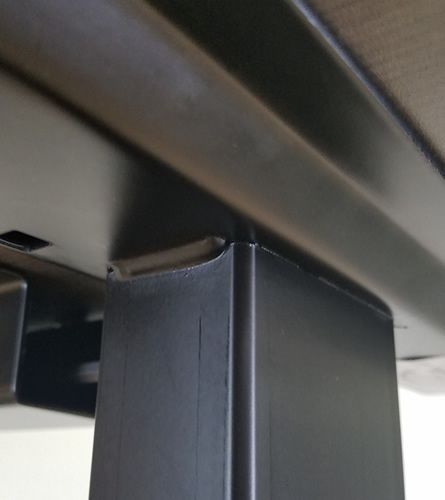
One Size Fits All Glide Systems
The third reason is within the actual column themselves. We have found through the testing of many Chinese made standing desks that many are using one size fits all glides. While this approach helps to cut down on the overall cost of the frame, it will also create a lot of inconsistencies across the same brand of desk.
Glides are designed to fit between columns; creating smooth movement and reducing the amount of wiggle or play between the columns. Because steel tubes will vary in their tolerances, a one size fits all approach won’t create a consistently stable frame. Higher-end brands will utilize multiple sized glides to create a more custom fit for each leg that is manufactured.

The Autonomous SmartDesk has a lot of play within their glides and this exaggerates the wobble and rocking motions. The VertDesk v3 utilizes three different sized glides that can be mixed and matched, creating a custom fit that allows for a more consistent column.
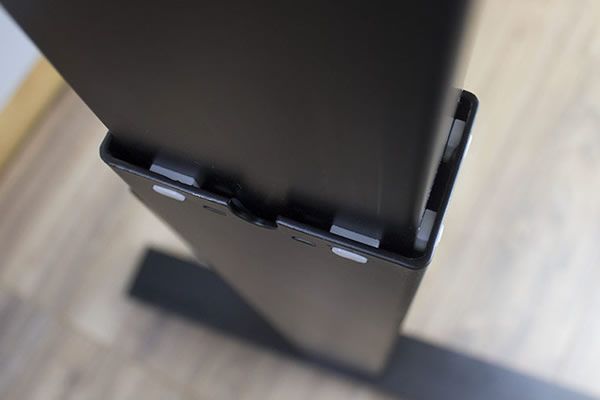
Traditional Cross Support
While the fourth reason for additional stability is fairly obvious, the traditional cross support cannot be overlooked. Standing desks without a traditional cross support have an inherent wobble issue due to their design. The Autonomous Desk uses a u shaped design, that puts the cross support directly underneath the desktop. As the desk is raised this cross support moves further from the bottom of the base and will naturally start to wobble the higher it moves from the lowest point of the frame. The VertDesk v3 utilizes a cross support system that is designed specifically for each size desk. The cross support height remains constant, minimizing wobble as the upper half of the desk is raised to standing height.
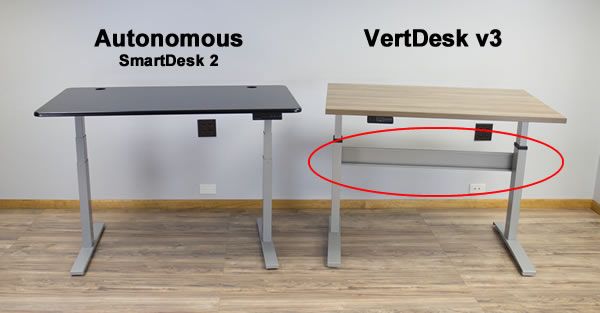
Electronics Comparison
The Autonomous SmartDesk 2 and VertDesk v3 both feature smart electronic control box systems. Autonomous SmartDesk 2 comes standard with a four preset programmable button. VertDesk v3 offers a standard two button, up and down switch. There is an optional programmable switch that includes four presets.
The Autonomous SmartDesk 2 currently uses TiMotion electronics. I have mentioned the issues we experienced using TiMotion on the VertDesk v1 and why we switched to a more consistent alternative on the v2 and v3. While the up/down switch on the SmartDesk 2 is different than what was used on VertDesk v1, the control box is exactly the same.
The VertDesk v3 uses electronics from the European manufacturer, Laing Innotech GmbH. This is the same electronics brand that is being used in the high-end line, NewHeights.
The difference between the two products is significant, with the TiMotion electronics in the Autonomous Desk being some of the lowest quality I have seen for a product in the mid-range. Like most of the other less expensive Chinese made desks, the Autonomous control box is made from a two-board system. The power supply utilized an inexpensive mass-produced board with the most excessive silicone caulk I’ve seen to date on any control box circuit board. The connection between the power supply and the mainboard was interesting as well, with the wires being held in place with more silicone caulk. Overall, there was no real consistency here and it left a lot to be desired.
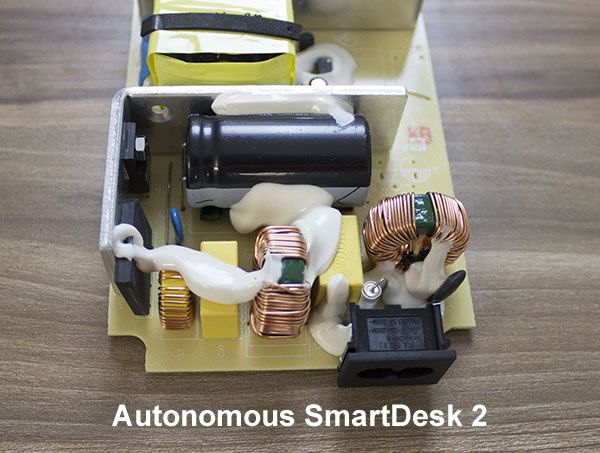
The VertDesk features a single board system that was engineered by Laing Innotech specifically for use in the electric standing desk control box. A four-layer circuit board was used to maximize functionality and create a small footprint. The components are securely fastened to the circuit board with solid platforms and permanent soldered connections.

The only real weakness we found with the board is the way the toroid core had been wrapped. Coming from a LogicData board, that had perfectly wrapped wires in copper, the one on the VertDesk wasn’t perfect. There is some overlap to the wrap that could be improved upon. We are currently working with Laing Innotech to improve on this and should hopefully be closer to the LogicData in future iterations.
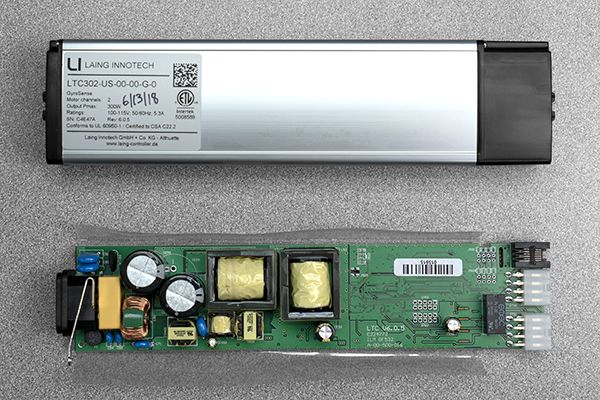
Weight Capacities and Testing
How Do They Operate
Both desks use a smart control box system with soft start and stop technology. Each desk includes a one-touch functionality, allowing you to press and release the button for movement. The VertDesk v3 requires the upgraded programmable switch to utilize this function. The Autonomous SmartDesk comes with the programmable switch.
Each desk also includes a collision-avoidance system that worked when tested. The Autonomous Desk comes with a software-driven collision avoidance system that is designed for hard collisions with items like furniture. The VertDesk v3 uses a GyroSense technology which includes an integrated gyro sensor, for better soft collision detection.
Frame Colors
Both desks are currently available in three colors: black, white and silver.
Optional Upgrades
| Autonomous SmartDesk 2 | VertDesk v3 | |
| Programmable Button | Standard | $49 |
| Locking Casters | n/a | $29/set |
| Wire Management Kit | $21 | $68 |
Return Policy
| Autonomous SmartDesk Pro | VertDesk v3 |
| 30 Days + Free Returns | 30 Days + Free Returns |
Warranty
| Autonomous SmartDesk Pro | VertDesk v3 |
| 5 warranty for electronics, which includes switch, motors and control box. The Autonomous desktops are covered for 1 year. | Lifetime warranty on everything. |
Bottom Line
The bottom line is that each of these desks could potentially be a good fit for you. The Autonomous SmartDesk Pro has an attractive price point and an adjustment range that will fit a large segment of the population. Autonomous also has the quickest adjustment speeds I have tested to date. The lower-end electronics from TiMotion and significant stability issues have the potential to be a deal-breaker though.
The VertDesk v3 is still the most stable standing desk we have tested within the mid-range of electric desks. The use of high-end electronics will likely mean fewer headaches throughout ownership and a longer lifespan post-warranty. The shorter adjustment range and lower weight capacity could be an issue depending on your needs.
While no desk will ever be perfect for everyone, the Autonomous and VertDesk v3 are likely to cover most user’s requirements. Hopefully, my comparison will help you to make a better buying decision.
More Standing Desk Resources
- The 4 Best Electric Standing Desks Under $800
- How long will your VertDesk v3 last? We tested to find out.
- VertDesk v3 vs. Jarvis Standing Desk
- Jarvis Desk Electric Adjustable Desk (Review / Rating / Pricing)
- VertDesk v3 Electric Standing Desk (Review / Rating / Pricing)
- A Standing Desk Evolution: VertDesk v1 and v2 VS. VertDesk v3







